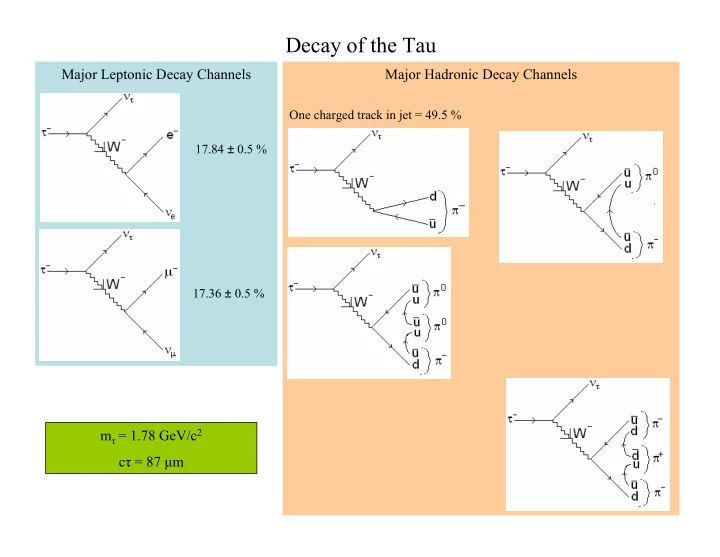

Decay�of�the�Tau Major�Leptonic Decay�Channels Major�Hadronic Decay�Channels One�charged�track�in�jet�=�49.5�% 17.84� ± 0.5�% 17.36� ± 0.5�% m τ =�1.78�GeV/c 2 cτ =�87�.m
Level�1�Tau Trigger�using�the�Hadronic and�Electromagnetic� Calorimeters�1 I 1. Take�a�12x12�grouping�of�trigger�towers�around�an�active�spot�as�a�generic�jet. 2. Each�4x4�region�showed�has�a�τ1veto�bit�associated�with�it.�If�more�than�2�trigger�towers�in�the� ECAL�or�HCAL�are�activated,�this�τ1veto�bit�is�set.�Each�trigger�tower�has�a�programmable�threshold of�typically�a�few�GeVs. 3. A�generic�jet�is�relabelled a�Tau Jet�if�none�of�its�nine�4x4�regions�have�a�τ1veto�bit�on. 4. The�four�highest�E T jets�and�the�four�highest�E T jets�identified�as�Tau Jets�are�sent�to�the�global� trigger�for�consideration�as�trigger�objects.
Level�1�Tau Trigger�using�the�Hadronic and�Electromagnetic� Calorimeters�1 II The�efficiency�of�Tau1Jet�identification�using�Level�1� algorithm�is�plotted�against�the�transverse�energy�of� the�jet.� The�drop�with�high�ET�maybe�because�higher� energies�cause�neighbouring trigger�towers�to�fire� occassionally. The�efficiency�of�Tau1Jet�identification�using�Level�1� algorithm�is�plotted�against�pseudorapidity.� It�falls�off�at�high�pseudorapidity presumably�because� the�Tau1Jets�are�incident�on�the�calorimeters�at�higher� incident�angles�and�trigger�multiple�towers.
Level�2�Tau Trigger�using�the�Electromagnetic�Calorimeter�1 I • Tau jets�are�more�collimated�than�QCD�jets. Define:�<R 2 =�<η 2 +�<Φ 2 We�exploit�this�collimation�by�requiring�that�the� transverse�energy�deposited�in�the�neighbourhood (0.13< � R<0.4)�of�the�highest�tower�be�below�a�cutoff� energy�P isol cut .�That�is: − ∑ ∑ = < cut E E P P T T isol isol � < � < R 0 . 4 R 0 . 13 Efficiency�of�accepting�simulation1generated�Tau and� QCD�jets�for�different�E T were�studied�using�a�detector� cut was�varied�from�0�GeV/c to�14�GeV/c simulation.�P isol and�efficiencies�were�plotted�against�it�as�shown�to�the� left. cut =�5� It�was�seen�that�QCD�jets�are�best�rejected�for�P isol Gev.
Level�2�Tau Trigger�using�the�Electromagnetic�Calorimeter�1 II cut =�5�GeV/c is�used�in�a�Monte�Carlo�test. P isol A�plot�between�the�Tau jet�identification�efficiency�in�the�ECAL�versus� transverse�energy�is�shown�to�the�right.�The�efficiencies�of�the different� channels�of�hadronic decay�are�separated. A�plot�between�the�Tau jet� identification�efficiency�versus� η is�shown�to�the�right.�The�drop�in� efficiency�with�increasing� η is�due� to�the�jet�having�to�pass�through� more�tracker�material�before� hitting�the�ECAL. A�supermodule section�of�the�ECAL�under�construction�is�shown�to�the� left.�Each�crystal�cross�section�corresponds�to� � R=9.2�x�10 18 ,�well� above�the� � R�resolution�required�for�the�definition�of�P isol cut .
High�Level�Tau Trigger�using�the�Pixel�Detector�1 I • Direction�of�the�Tau Jet�Axis�is�determined�by�jet� reconstruction�in�the�calorimeter. •A�Matching�Cone�of�solid�angle�R m around�the�Jet�Axis� is�drawn. •Only�tracks�within�the�Matching�Cone�with�transverse� momentum�greater�than�p m T are�considered. •The�track�with�the�highest�transverse�momentum�among� them�is�called�the�Leading�Track. •A�Signal�Cone�of�solid�angle�R s around�the�Leading� Track�is�drawn. •All�tracks�within�the�Signal�Cone�which�have�a�z1 impact�parameter�less�than�<z tr away�from�the�z1impact� parameter�of�the�Leading�Track�are�considered�part�of� the�Tau Jet.�There�must�be�1�or�3�such�tracks. •An�Isolation�Cone�of�solid�angle�R I is�drawn�around�the� Jet�Axis. •All�tracks�within�the�Isolation�Cone�that�have�z1impact� parameter�less�than�<z tr away�from�the�z1impact� parameter�of�the�Leading�Track�and�with�transverse� momentum�greater�than�p I T are�considered.�If�they�are� found�only�within�the�Signal�Cone,�the�isolation�criterion� for�the�Tau Jet�is�satisfied.
High�Level�Tau Trigger�using�the�Pixel�Detector�1 II
Performance�of�High�Level�Tau Trigger�with�H/A/h→τ + (jet)τ 1 (jet) Two�schemes�for�HLT�on�the�table,�really. • Use�the�ECAL�+�Pixel�Detector.�Codename:� �������� . • Use�the�Silicon�Tracker.�Codename:� ��� ��� . Calo+Pxl Algorithm Rate�of�events�coming�out�of�Level�1�is�suppressed�by�a�factor�of�3�using�ECAL�Isolation�with� cut =5�GeV/c on�one�of�the�two�jets. P isol 1. Tracker�isolation�is�applied�to�both�jets.�Track�reconstruction�required�for�this�is�done� entirely�by�the�Pixel�System. 3�pixel�hits�is�sufficient�to�reconstruct�tracks.�Essentially,�2 of�the�3�hits�are�used�first� and�matched�in� r�Φ and� z�r to�establish�track�candidates.�The�matching�cuts�are� optimised for�tracks�of� p T ~1�GeV/c .�Valid�pixel�pairs�are�matched�with�the�3 rd pixel�hit� forming�pixel1tracks.�The�momentum�of�these�pixel1tracks�is�reconstructed�without�a� primary�vertex�constraint.�A�list�of�primary�vertices�where�tracks�cross�the�z1axis�is� drawn�up.�Primary�vertices�(and�their�tracks)�with�at�least�3�tracks�are�kept,�and�the� rest�are�deleted. R M =0.1,�p T ltr =3�GeV/c,�R S =0.07,�R i = free�parameter. 2. The�first�jet�defines�primary�vertex.�All�tracks�of�both�jets�must�originate�there,�else�deleted.
Performance�of�Calo+Pxl with�H/A/h→τ + (jet)τ 1 (jet) Efficiency�of�accepting�signal�events�versus� efficiency�of�accepting�QCD�multi1jet�events� is�plotted�on�the�right.�The�Calo1Pxl algorithm�is�applied�to�the�first�jet.�Two� Higgs�Boson�masses�of�M H =200�and�500� GeV/c 2 are�used.�R i is�varied�from�0.2�to�0.6� in�steps�of�0.05 The�Calo1Pxl algorithm�is�now�applied�to� both�jets.�The�first�jet�is�used�to�decide�the� primary�vertex�wherefrom�all�tracks�in�both� jets�must�originate.�QCD�suppression�is� definitely�improved.
H/A/h→τ + τ 1 →.,�jet�Event�Generation�and�Pre1selection ���������������� Signal • H/A/h→�τ + τ 1 done�in�PYTHIA • τ + τ 1 →(.νν)(hadronic jet�+�ν)�done�in�TAUOLA Background • Drell Yan Z/γ *� →τ + τ 1 →(.νν)(hadronic jet�+�ν)�produced�in�two�bins:�40�<�m ττ <�120� GeV/c 2 and�m ττ >�120�GeV/c 2 • ττbb was�produced�with� 60�<�m ττ <�100�GeV/c 2 and�m ττ >�100�GeV/c 2 • W+jet was�produced�with�p T >�20�GeV/c • tt • Wt • SUSY�background�negligible ������������ • Muon�was�isolated�with�no�charged�particle�with�p T >�1�GeV/c within�a�solid�angle�of�0.2 • Tau1Jet�isolated�with�at�most�1�charged�track�at�solid�angle�>�0.1�and�<�0.4�.�Leading�track�in�this� jet�required�to�have�p T >�3�GeV/c.
H/A/h→τ + τ 1 →.,�jet�Offline�Event�Selection • Tau1Jet�identification.�Is�almost�identical�to�Calo1Pxl identification.�Except: • instead�of�hastily�created�pixel1tracks,�fully�reconstructed�tracks�are�used. • instead�of�using�Jet�Axis�defined�by�ECAL,�sum�of�the�momenta�of�reconstructed�tracks�is�used. • the�leading�track�should�have�p T >�10�GeV/c for�1�track�in�signal�cone�or�p T >�20�GeV/c for�3� tracks�in�signal�cone. • b�tagging�of�at�least�one�b1Jet�is�required�to�make�sure�we�are�dealing�with�bbH(A).�One�b1jet�with�p T >�20�GeV/c was�required. • Events�containing�the�decay�of�(a�nearly�on1shell)�W�into�.+ν . are�rejected�by�a�cut�of�60�GeV/c 2 on� the�invariant�mass�of�the�W. • Central�Jet�Veto:�All�events�containing�more�than�just�the�Tau and�b�jets�in�|η|<2.5�with�E T >20�GeV are�rejected.�Reduces�tt background. • E HCAL /p ltr cut. • Reconstructed�muon�and�τ1jet�cannot�be�back�to�back. • Events�with�negative�reconstructed�neutrino�energy�rejected.
Recommend
More recommend